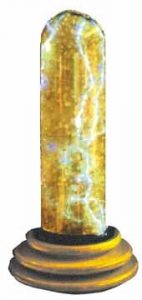At the recent ISA show, we were asked several times about how "crackle tubes" are made. Crackle tubes are a special effect tube, usually neon filled, that gives the effect of thin, bright lightning constantly changing paths through the tube.
The simple answer is that the effect is caused by filling a glass tube with any of a variety of media (usually glass), balls, tubing pieces, rings, glass aquarium sand, etc., which creates channels through which the gas discharge must pass.
Making a crackle tube
Crackle tubes look better when made from large-diameter tube (20-25mm). Above 25mm, the lightning effect can get lost in the interior.Although the discharge still moves and glows, much of the discharge can be buried too deep in the glass to look interesting.
The tubing can be almost any shape, however the tube must be filled with glass pieces later, making anything with sharp bends difficult to fill. After bending the outline of the tube, seal one end by attaching an electrode. The second electrode is left off until after filling with the glass.
As mentioned a variety of types of glass can be used. Glass balls are probably the easiest to use (also to fill, get clean, etc.). Although it’s not critical, the glass balls should be of the same material as the tube if possible to help eliminate some future expansion and outgassing problems. (A convenient source for small quantities of both borosilicate and soda lime glass balls is the Fredrich and Dimmock Co., Millvale, NJ. Phone: (800) 524-1131.I know from experience that their glass is very clean and uniform in diameter.) $image1
Advertisement
Other types of glass fill providing interesting effects include pieces of cut up tubulation glass, ceramic rasching rings, and even tubes filled with fairly long sections of colored or coated glass tubing. Different diameters and packings of materials also can give interesting effects.
Any fill material used must be thoroughly cleaned. A tube filled with beads, for example, will usually have many times the surface area of fill material than the outside glass envelope. Even a small amount of impurity on the beads adds up quickly and can poison the gas fill later.
The ideal cleaning method for the filling media is first to rinse all the glass with a strong reagent-grade solvent to lift any oils or grease-like contaminants. Secondly, a weak solution of hydrofluoric acid is used followed by a thorough rinsing of distilled water and then hot air drying. This cleaning method is an ideal one, but not necessary for most applications. Obviously, after cleaning, the beads or glass pieces should not be handled without lint-free gloves.
The glass pieces can now be poured into the tube and the second electrode sealed on. The glass must fill the tube completely. If it settles and it creates a wider channel , this will be the lone path that the discharge will follow.
One other caution: Electrode shells shouldn’t be in contact with the filling media. This requires some form of baffle, either dimples in the electrode neck or "necking down" the electrode glass so that the glass media won’t pass through. The tube will operate without this cautionary step, but may not operate very long.
With the tube filled and the electrodes sealed on, the tube needs to be baked in an oven. The baking further outgasses the tubing and fill media. Preferably , the oven temperature should be nearly the annealing point of the glass tubing. If desired, the tube can be baked out under vacuum, but doing this requires the temperature to be somewhat lower. At annealing temperatures, the glass can start to collapse under vacuum.
Advertisement
After baking for at least 1/2 hour (minimum) and while the tube is still fairly hot, the tube can be removed from the oven and put on a vacuum manifold and evacuated. A crackle tube can’t be evacuated like an ordinary neon tube, because the bombarding current would unevenly heat the tube, causing some parts to suck in while others wouldn’t even be hot. After oven heating, the hot glass filling media will hold a great deal of heat for a good length of time, which will aid pumping.Use an induction heater to heat the electrodes for outgassing and converting the shell coatings. This should be done quickly while the rest of the tube is as hot as possible to prevent reabsorption of the gases.
After thoroughly heating and evacuating, fill gas can be put in. Neon is the best choice, because it is the brightest gas available. Argon or neon with mercury is often a problem, because mercury seems to darken readily over time in this kind of tube. Other gases &emdash; krypton, xenon and helium &emdash; really don’t give much light, and helium gets very hot.
The filling pressure is not the same as filling a conventional neon tube. Depending on the activity level desired, the tube can be filled from 20-100 torr. The higher the pressure, the more active the tube. With higher pressures, the tube will also require significantly higher voltages and take longer to age in.
To power a crackle tube, a conventional core-and-coil transformer works best. (Try a solid state transformer, and you’ll quickly see why they’re not used. Instead of thin discharges, some solid state units very nicely light everything in the tube, preventing the lightning effect.)
Crackle tubes are somewhat time consuming to make, but they add a visually appealing kinetic action that can add dazzle to signs or art pieces.



 Tip Sheet1 week ago
Tip Sheet1 week ago
 Ask Signs of the Times3 days ago
Ask Signs of the Times3 days ago
 Photo Gallery1 day ago
Photo Gallery1 day ago
 Real Deal1 week ago
Real Deal1 week ago
 Benchmarks6 days ago
Benchmarks6 days ago
 Editor's Note2 weeks ago
Editor's Note2 weeks ago
 Women in Signs1 week ago
Women in Signs1 week ago
 Photo Gallery1 week ago
Photo Gallery1 week ago










